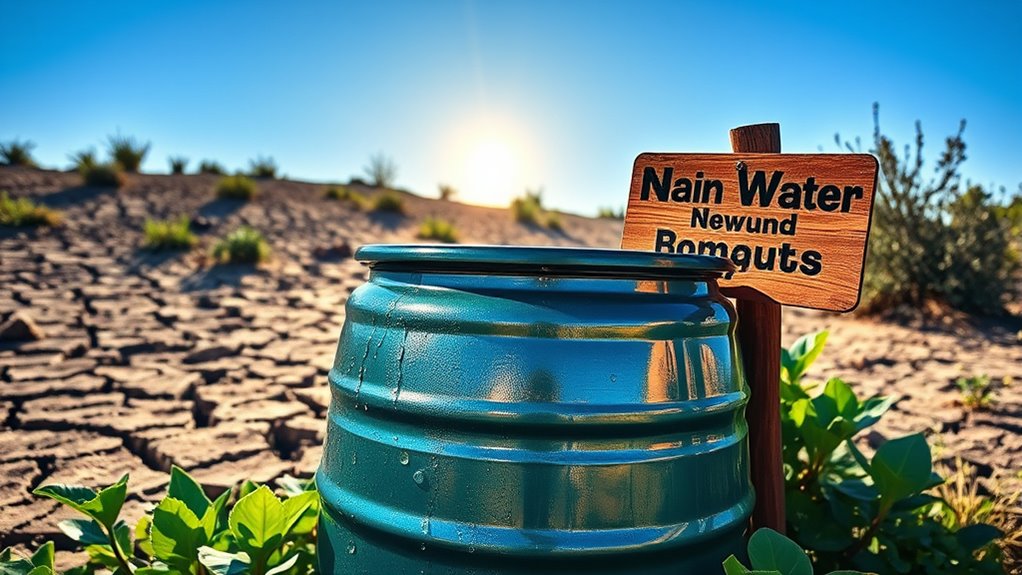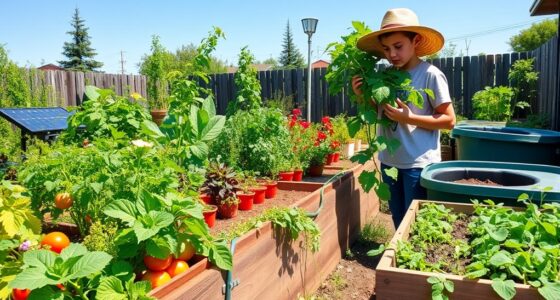In drought-prone states, rainwater harvesting laws are getting more relaxed to address water scarcity. States like Colorado have embraced collection systems for residential use, while Utah requires easy registration for such systems. Nevada has made it more accessible for residents to collect rainwater for non-potable uses without permits. As awareness grows about the benefits of rainwater harvesting, you’ll discover how these changes can lead to economic incentives and enhance conservation efforts.
Key Takeaways
- States like California and Arizona have relaxed laws and offer incentives to encourage rainwater harvesting amid ongoing drought conditions.
- Nevada’s recent legislative changes allow non-potable rainwater collection without permits, promoting efficient water usage during droughts.
- Colorado legalized rainwater harvesting for residences, permitting outdoor use, which helps mitigate drought effects on water resources.
- Georgia has minimal restrictions, empowering residents to harvest rainwater and support conservation efforts during drought periods.
- Public awareness and community involvement are crucial in promoting relaxed rainwater harvesting laws and practices in drought-affected areas.
Overview of Rainwater Harvesting Laws in Drought-Prone States
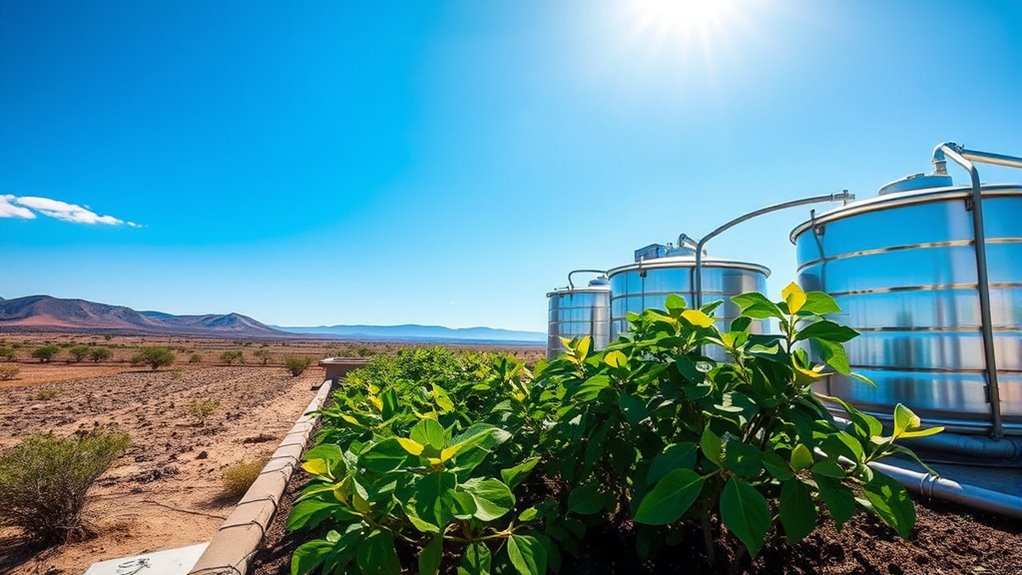
As drought conditions become more prevalent, understanding the laws surrounding rainwater harvesting in drought-prone states is essential for effective water management. Most states allow rainwater harvesting, but regulations vary considerably.
Some states, like California and Arizona, actively encourage rainwater collection with incentives, while others, such as Nevada and Utah, impose strict regulations to protect water rights and broader systems. In Utah, for instance, you’ll need to register larger systems, whereas Georgia has minimal restrictions.
Understanding these regulations helps you navigate the legal landscape and maximize the benefits of rainwater harvesting. Not only can it reduce your water bills, but it also fosters economic resilience and contributes to water conservation during critical drought periods.
Colorado’s Progressive Approach to Rainwater Collection
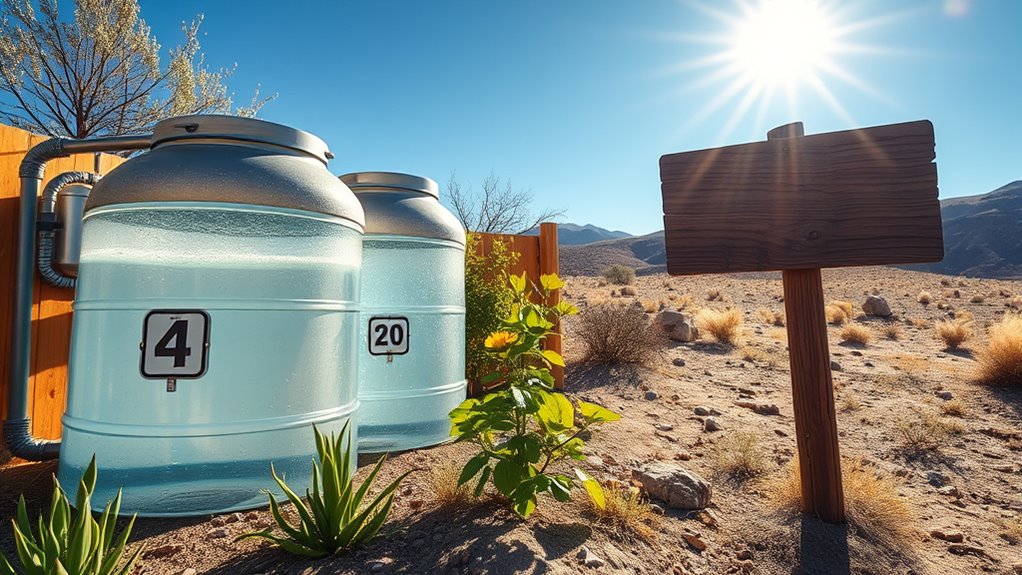
Colorado has taken significant strides in embracing rainwater harvesting, especially since the 2016 legislation lifted the longstanding prohibition.
Now, you can legally collect rainwater at single-family and multi-family residences with fewer than four units, using up to two rain barrels with a combined capacity of 110 gallons. This change allows you to utilize collected rainwater for outdoor purposes, like watering gardens or washing cars.
However, indoor use or drinking is strictly prohibited due to health risks from potential contaminants. By adopting this practice, you not only conserve municipal water supplies but also help reduce stormwater runoff.
Following best practices, like maintaining your rain barrels and ensuring they’ve sealable lids, is essential for effective and safe rainwater collection.
Utah’s Registration Requirements for Collection Systems

If you’re considering rainwater harvesting in Utah, it’s essential to understand the registration requirements that come with it. Under Senate Bill 32, you must register your collection system with the Utah Division of Water Rights.
The process is straightforward, requiring minimal details like your name, phone number, address, email, and storage size. Plus, it’s free! You’ll receive a certificate as proof of registration, which you should keep for your records.
Nevada’s Legislative Efforts and Challenges
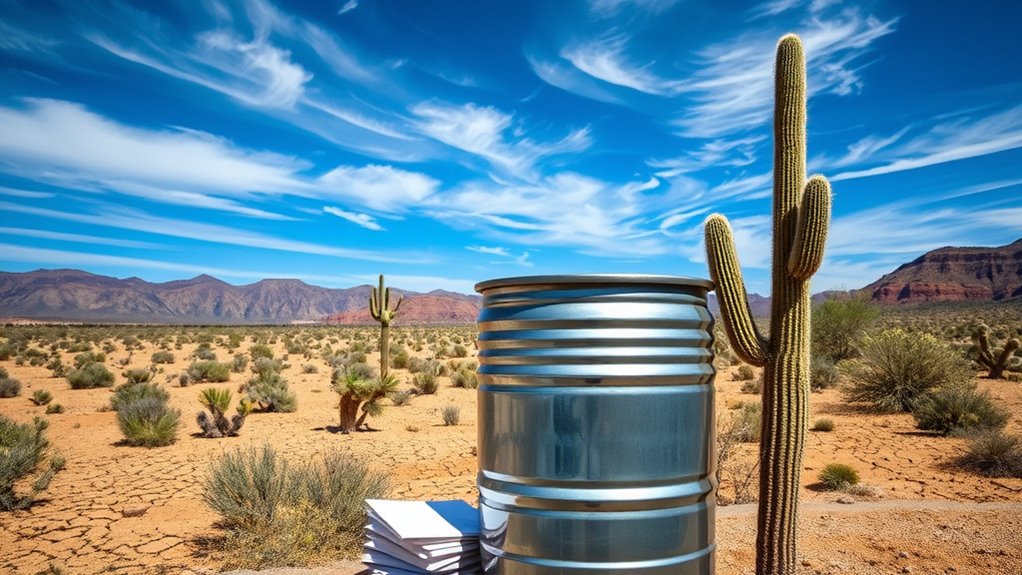
Utah’s registration requirements for rainwater harvesting represent a significant step in water conservation efforts, but Nevada has taken its own legislative strides to address similar challenges.
Since the passage of Assembly Bill 138 in 2017, you can legally collect rainwater from your rooftop for non-potable uses without a permit, a marked change from prior restrictions. This move promotes water efficiency and reduces environmental impact.
However, large-scale systems still require permits, and some municipalities may impose visibility restrictions.
As Nevada navigates its unique water rights and conservation needs, the focus remains on balancing individual rights with broader water management goals.
Future legislation may further enhance rainwater harvesting, making it more accessible for residents.
Arkansas’s Support for Potable and Non-Potable Uses

While Arkansas may not have specific regulations for rainwater harvesting, it actively supports both potable and non-potable uses through its existing legal framework.
You can harvest rainwater for non-potable applications like flushing toilets and urinals without specific prohibitions. Just verify your system is designed by a licensed engineer and complies with the Arkansas Plumbing Code, including cross-connection safeguards to protect potable supplies. Additionally, implementing eco-friendly practices in rainwater harvesting systems can enhance efficiency and conservation efforts.
Furthermore, using rainwater for agricultural and outdoor purposes enhances water conservation efforts and reduces costs. Furthermore, rainwater harvesting can significantly contribute to water conservation efforts, which is crucial in drought-prone areas.
Although Arkansas doesn’t currently offer incentives for rainwater harvesting, community engagement in this practice promotes environmental sustainability.
Drought Resilience and Water Security Benefits

As communities face the increasing threat of drought, rainwater harvesting emerges as a crucial strategy for enhancing water security. By collecting and storing rainwater, you can secure a valuable resource during dry spells. This practice helps recharge aquifers, maintaining groundwater levels essential for long-term sustainability.
Additionally, rainwater harvesting reduces flood risks by minimizing stormwater runoff, boosting community resilience against varying weather extremes. Implementing these systems decreases reliance on strained municipal supplies, especially during peak demand.
Rainwater harvesting mitigates flood risks and enhances community resilience by reducing stormwater runoff and easing pressure on municipal water supplies.
Plus, it offers a cost-effective alternative to costly infrastructure upgrades. By using harvested rainwater for irrigation, you can improve soil quality and support agricultural productivity, promoting healthier ecosystems even in drought conditions.
Embracing this practice aligns with community sustainability goals.
Economic Incentives for Rainwater Harvesting Adoption
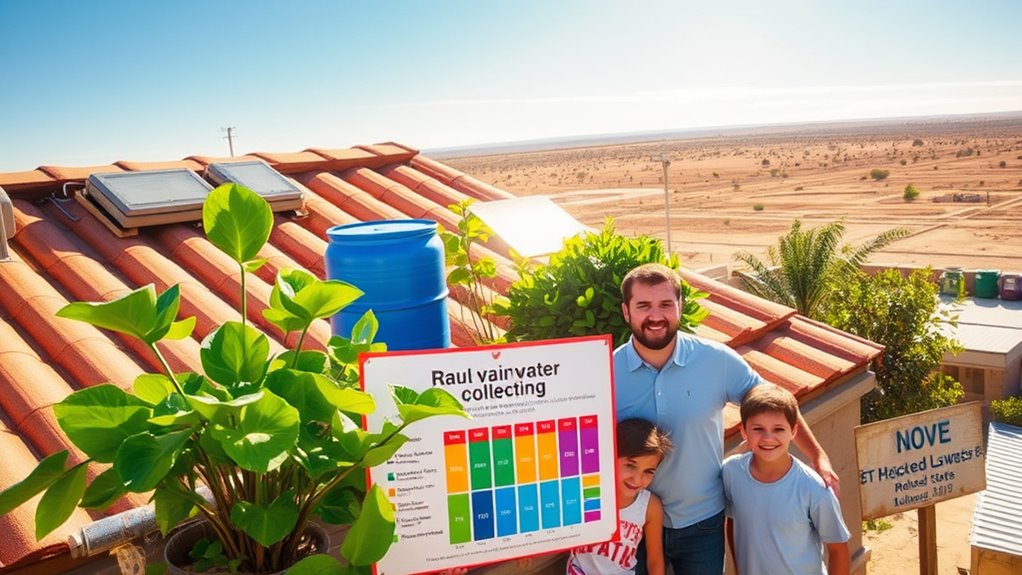
Rainwater harvesting not only boosts drought resilience but also offers significant economic benefits that can encourage its widespread adoption. Many governments provide subsidies, tax credits, and rebates to offset installation costs, making these systems more accessible for households and businesses.
For instance, Arkansas offers a Groundwater Conservation Tax Credit, while Georgia provides rebates up to $2,500. By implementing rainwater harvesting, you can reduce your water bills and improve operational efficiency. Additionally, these systems align with sustainable agriculture practices that promote water conservation and enhance ecosystem health.
Furthermore, adopting sustainable practices enhances your brand image, attracting environmentally conscious customers. These financial incentives not only alleviate initial costs but also promote long-term savings, making rainwater harvesting an attractive investment for anyone looking to contribute to water conservation and boost their economic standing. Furthermore, the adoption of renewable energy technologies is expected to complement such practices by increasing overall sustainability efforts.
Technological Innovations Enhancing Collection Efficiency

Advancements in technology are transforming rainwater harvesting systems, making them more efficient and user-friendly.
Smart systems now monitor weather patterns, water levels, and consumption rates in real time, allowing you to make quick adjustments for ideal water usage. Automation features adjust irrigation schedules based on forecasts, reducing water wastage.
Enhanced filtration technologies, like UV treatment, guarantee water quality, making it safe for various uses, even drinking.
Sustainable designs, such as green roofs and permeable pavements, integrate seamlessly into urban infrastructure, improving aesthetics while managing water efficiently.
Modular systems provide flexibility, adapting to properties of all sizes and making installation a breeze.
These innovations collectively enhance the effectiveness of rainwater harvesting, guaranteeing reliable water sources in drought-stricken areas.
Environmental Impact of Rainwater Harvesting Practices
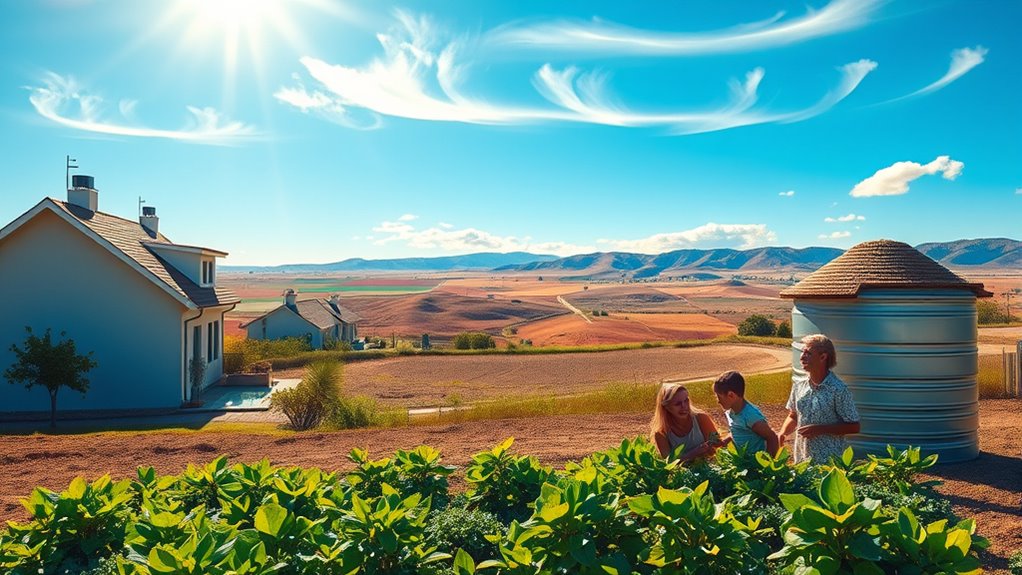
When you implement rainwater harvesting practices, you not only secure an essential water source but also positively impact the environment.
By capturing rainwater, you reduce the strain on traditional water sources, helping to conserve groundwater and maintain balanced ecosystems. This practice minimizes pollution from stormwater runoff, supporting cleaner rivers and lakes while promoting biodiversity.
Capturing rainwater helps conserve groundwater, reduce pollution, and promote biodiversity for healthier ecosystems.
You also contribute to flood management, decreasing urban flooding risks and protecting infrastructure from heavy rainfall.
Furthermore, rainwater harvesting enhances drought resilience by providing an alternative water source, stabilizing water prices, and supporting agriculture during dry spells.
Ultimately, these practices lead to sustainable development, integrating efficient water management into urban planning and fostering long-term environmental sustainability.
Importance of Public Awareness and Education on Regulations
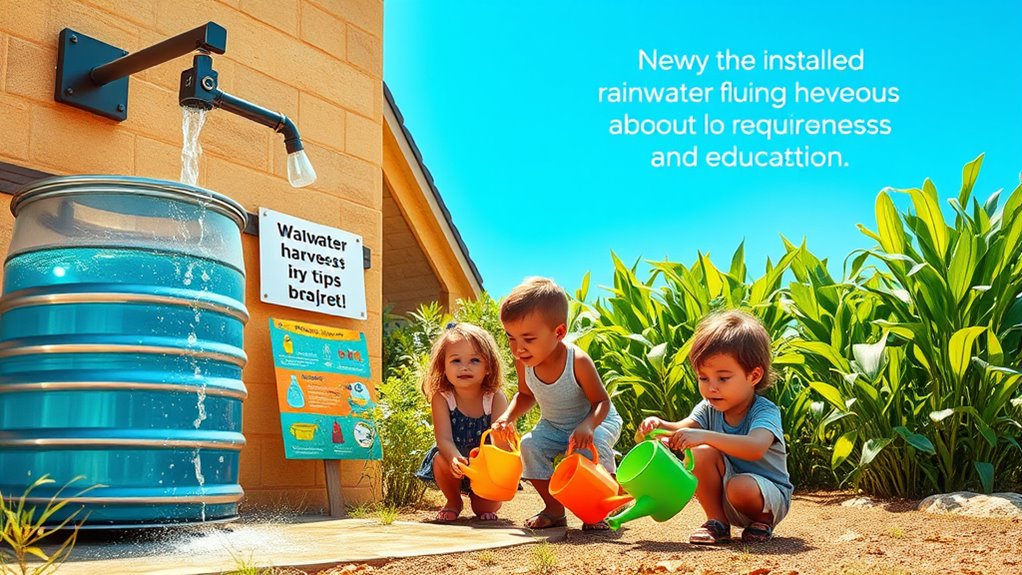
Understanding the regulations surrounding rainwater harvesting is essential for anyone looking to implement this sustainable practice. A lack of awareness can lead to non-compliance, leaving you vulnerable to fines. Since regulations vary greatly from state to state, it’s important to stay informed.
Misinformation about water rights may deter you from setting up a system, but public education can clarify these misconceptions. Local authorities play a significant role in sharing accurate information, while workshops and online resources can enhance your understanding.
Engaging with community events can foster a supportive network, making it easier for you to adopt this practice. Increased awareness not only benefits you economically but also promotes sustainable water conservation efforts in your area.
Frequently Asked Questions
How Can I Install a Rainwater Harvesting System at Home?
To install a rainwater harvesting system at home, start by evaluating your roof surface and determining your water needs.
Choose the right size tanks, gutters, and filtration systems within your budget.
Install gutters with screens and a first flush diverter to keep contaminants out.
Set up storage tanks and pumps to distribute the water.
Regularly maintain the system by cleaning and inspecting components to guarantee efficient operation and safe water quality.
What Are the Costs Associated With Rainwater Harvesting Systems?
When you’re considering rainwater harvesting systems, you’ll face a range of costs depending on your needs.
Basic setups like rain barrels can start around $120, while more extensive systems might reach up to $21,000.
You’ll also need to factor in installation fees if you hire a professional.
Remember, ongoing maintenance is essential, so budget for that too.
Ultimately, investing in a rainwater system can help lower your utility bills and conserve water.
Are There Maintenance Requirements for Rainwater Collection Systems?
Yes, there are maintenance requirements for rainwater collection systems.
You should perform routine inspections of the roof and gutters to keep them clear of debris.
Regularly clean filters and first flush devices to guarantee water quality.
Check storage tanks for leaks and sediment, and maintain piping systems to prevent contamination.
Following an Operations and Maintenance manual helps you stay compliant and guarantees your system operates efficiently throughout the seasons.
Can Harvested Rainwater Be Used for Drinking?
Imagine sipping the purest, freshest water straight from the sky! Yes, you can use harvested rainwater for drinking, but it’s gotta be treated properly.
You’ll need layers of filtration, UV disinfection, and maybe even distillation to guarantee it’s safe and tasty. With the right system in place, you’ll transform that rainwater into a revitalizing treat.
Just keep up with maintenance, and you’ll have a reliable source of clean water right at home!
What Types of Filtration Systems Are Recommended for Rainwater?
When considering filtration systems for rainwater, you’ve got several effective options.
Start with mechanical pre-tank filters to catch debris, then use sediment filters to remove particulate matter.
Carbon filters can enhance taste and odor, while UV light disinfection neutralizes harmful pathogens.
For thorough protection, consider multi-stage systems that combine these technologies.
Regular maintenance and monitoring are essential to guarantee your water remains clean and safe for use.
Conclusion
In summary, relaxing rainwater harvesting laws in drought states opens up new opportunities for sustainable water management. For instance, imagine a Colorado homeowner who installs a rainwater collection system that not only waters their garden but also reduces their water bill markedly. By embracing such practices, you can contribute to conservation efforts while enjoying the benefits of self-sufficiency. It’s essential to stay informed about local regulations to maximize these advantages and help combat the ongoing water crisis.

